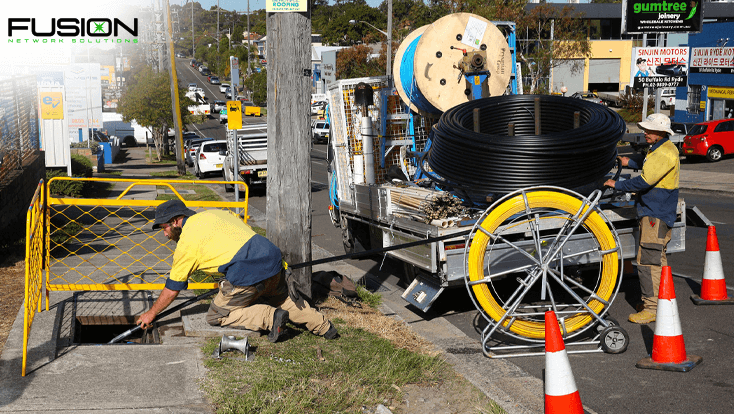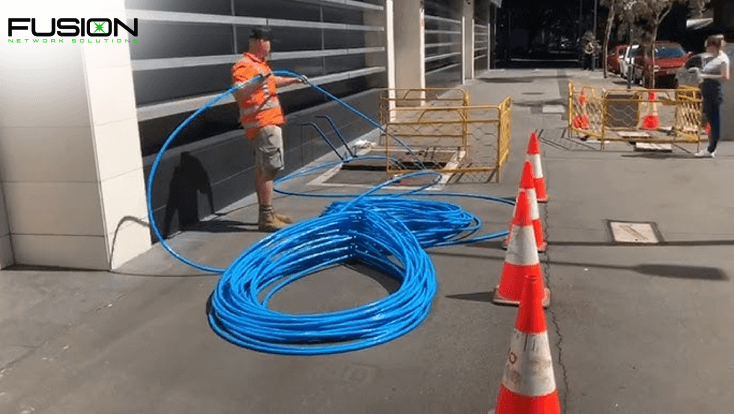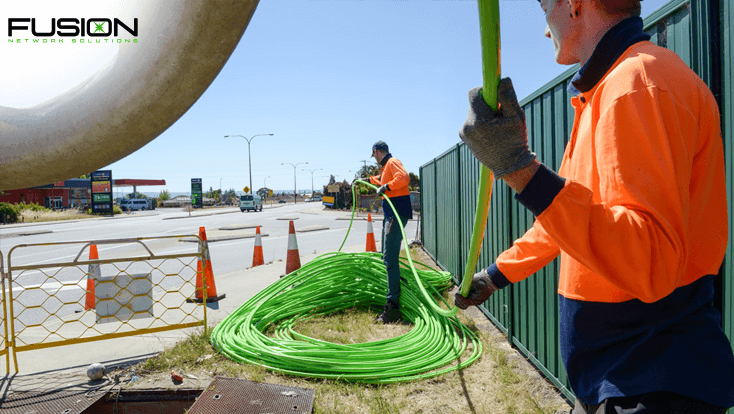In the rapidly changing world of telecommunications, fibre optic cable hauling is a crucial factor in providing high-speed, high-performance networks. As the technology keeps improving, the foundations—literally—remain challenging. Poor hauling methods can damage the integrity of the fibre, translating into expensive repair work, delays in projects, and compromised performance.
At Fusion Network Solution, we’ve experienced the costly long-term implications of avoidable errors in fibre optic cable hauling. In this blog, we’ll discuss the most frequent errors in fibre hauling and provide actionable advice to help you steer clear of them. Whether you’re coordinating sub duct installation, coordinating pit and pipe installation, or performing OTDR testing, these recommendations can enhance your project results and guarantee network reliability.
1. Overlooking Pre-Haul Planning
The Mistake:
Rushing into fibre optic cable hauling without a clear plan for the most part results in hiccups during the haul—route conflicts, unforeseen hurdles, or non-optimal routes.
How to Avoid It:
Prior to any hauling, carry out an extensive site survey. Plot the sub duct installation route and communicate with civil works teams to have all pits and pipes excavation carried out and ready for hauling. A well-defined plan covering duct routes, bend radii, and tension limits minimizes the risk of damage.
2. Poor Quality or Incomplete Sub Duct Installation
The Mistake:
Employing faulty ducts or failing to place them properly undermines the integrity of the whole fibre optic cable towing operation. Kinking or severe bending may cause damage to the cable or be impossible to pull. How to Prevent It:
How to Avoid It:
Make sure that sub duct installation is properly carried out with high-quality materials and technique. Prevent over-bending and properly secure all joints and transitions to avoid movement when the cable is hauled. Clean and inspect the ducts using mandrels and sponge pigs prior to cable pulling.
3. Improper Cable Hauling Tension
The Mistake:
Over-applying tension while fibre optic cable hauling can elongate or fracture the fibres. Conversely, not enough tension can result in sagging, knotting, or placement irregularities in the duct.
How to Avoid It:
Use a tension-monitored calibrated cable hauling winch. Always comply with the manufacturer’s specified maximum tension for pulling. Pulling lubricants can also help reduce friction, particularly in long pulls or when pulling through several pit and pipe installation.
4. Missing Pit and Pipe Inspection Prior to Hauling
The Mistake:
Not inspecting pit and pipe installation prior to hauling is a disaster waiting to happen. Debris, water, or structural problems will clog up the cable and cause damage.
How to Avoid It:
Conduct thorough inspection of all pits and pipes excavation prior to hauling. Clean and structurally sound pits free from debris. Verify all pipes are well connected, no sharp edges or blockages that can snag or cut the cable.

5. Failure to Use Proper Hauling Techniques for Environment
The Mistake:
Applying the same hauling technique to all jobs—regardless of the conditions on the site—can lead to unnecessary cable or infrastructure wear and tear.
How to Avoid It:
Make your choice on a site-by-site basis. Blowing could be more effective on long distance or complicated runs, whereas pulling could be the better option on shorter, straight runs. External conditions such as temperature, terrain, and duct configuration should all have an effect on your method of hauling.
At Fusion Network Solution, our engineers assess each project to determine the best method, ensuring safer and more efficient fibre deployment.
6. Poorly Managed Cable Reels
The Mistake:
Improper handling or placement of the cable reel during fibre optic cable hauling can introduce twists and kinks in the cable, weakening the signal or causing physical damage.
How to Avoid It:
Always unwind cable from a turntable reel placed in the right orientation. Mount the reel on a jack stand and make sure the cable runs freely and smoothly into the duct. Keep the reel level and never drag the cable along the ground.
7. Ignoring Fibre Optic Test Procedures
The Mistake:
Omitting post-haul fibre testing will conceal issues that might undermine the entire network. Microbends or cable breaks might not be apparent but still influence performance.
How to Avoid It:
Following hauling, perform a complete fibre optic test to confirm the cable is intact. This involves OTDR testing to identify bends, splices, or faults along the fibre path. Record results and compare to baseline measurements to guarantee quality.
8. Lack of Proper Training and Communication at Site
The Mistake:
Untrained personnel or lack of site communication may cause avoidable mistakes, ranging from excessive tensioning to incorrect cable handling.
How to Avoid It:
Invest in training your crew. All persons responsible for fibre optic cable hauling, sub duct installation, or pit and pipe installation should be familiar with the process and safety procedures. Clarify responsibilities, have pre-start meetings, and employ two-way communication to oversee each step of the operation.
9. Underestimating the Importance of Cleanliness
The Mistake:
Failing to maintain ducts, pits, and workspaces clean can introduce dirt, water, or debris into the fibre performance.
How to Avoid It:
All ducts should be cleaned prior to starting any fibre optic cable hauling with the aid of a mandrel and sponge test. Pits and pipes excavation should be free of sharp stones or other debris. A clean haul path eliminates damage to the cable and guarantees enhanced long-term performance.

10. Not Documenting the Hauling Process
The Mistake:
Omitting documentation may save time on the job, but it makes troubleshooting or auditing work later problematic.
How to Avoid It:
Document it all—sub duct installation through the outcome of every fibre optic test. Record reel numbers, pulling tension logs, OTDR test results, duct paths, and installation pictures. This history is priceless for maintenance and future expansions.
Final Thoughts
Fibre optic cable hauling is an essential component of any contemporary telecoms project—and one that does not allow for mistakes. The slightest mistake in hauling, sub duct installation, or pit and pipe installation can result in network breakdowns that take time and money to correct.
We take pride in doing it right the first time at Fusion Network Solution. With skilled engineers, certified technical staff, and adherence to best practices, we ensure that all projects exceed quality and safety standards.
From accurate pits and pipes excavation to exhaustive fibre optic testing including cutting-edge OTDR testing, we provide future-proof solutions built for speed and reliability.
Key Takeaways
- Always schedule your fibre haul with a full site survey.
- Verify quality and integrity in the sub duct installation prior to hauling.
- Keep tension under close control to safeguard the fibre.
- Check and clean all pit and pipe installation.
- Utilize the correct tools, trained staff, and document procedures.
Avoiding these common errors isn’t simply a matter of costs.—it’s about creating networks that endure.
Need Professional Fibre Hauling Support?
Whether you’re undertaking a large-scale infrastructure build or concentrated rollout, Fusion Network Solution provides specialized assistance with fibre optic cable hauling, sub duct fitting, and complete fibre deployment, such as fibre optic testing and OTDR testing. Get in touch with us today and discover how we can assist your next fibre project with accuracy and attention to detail.
